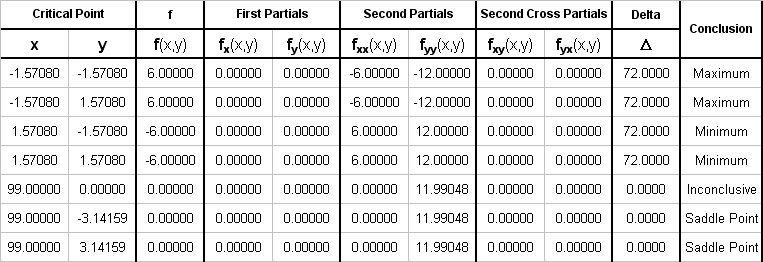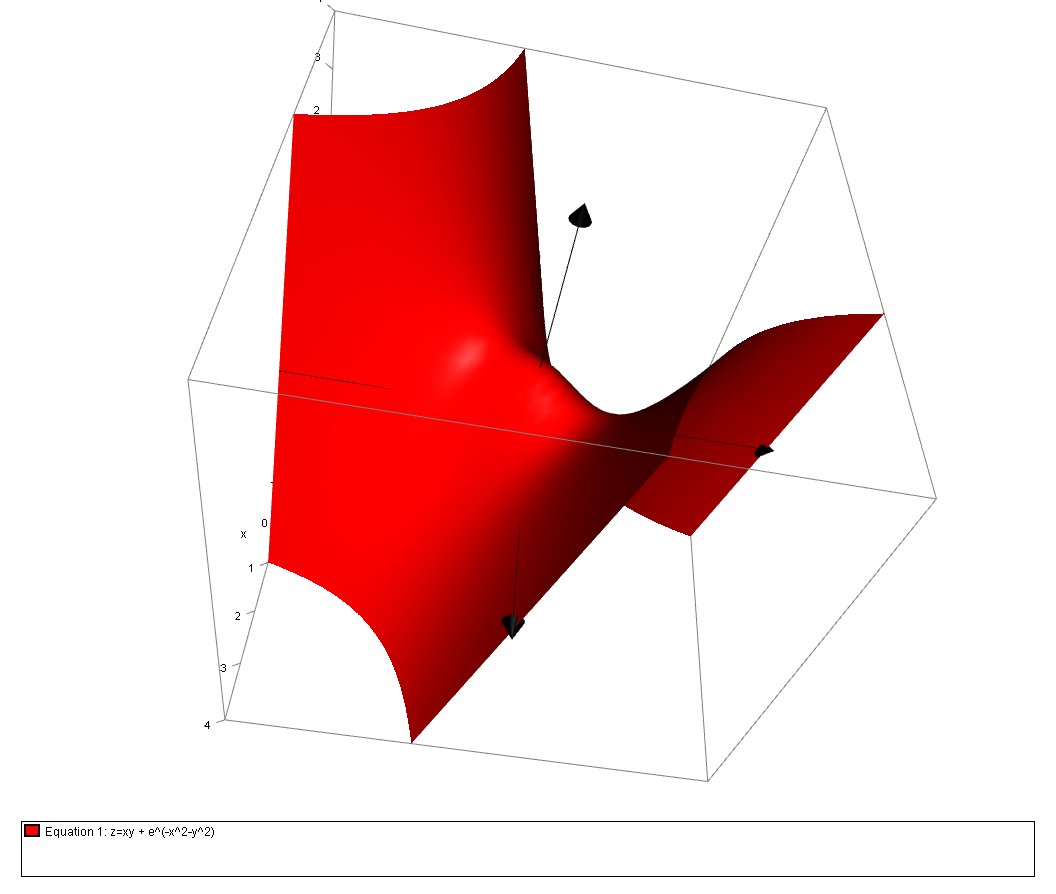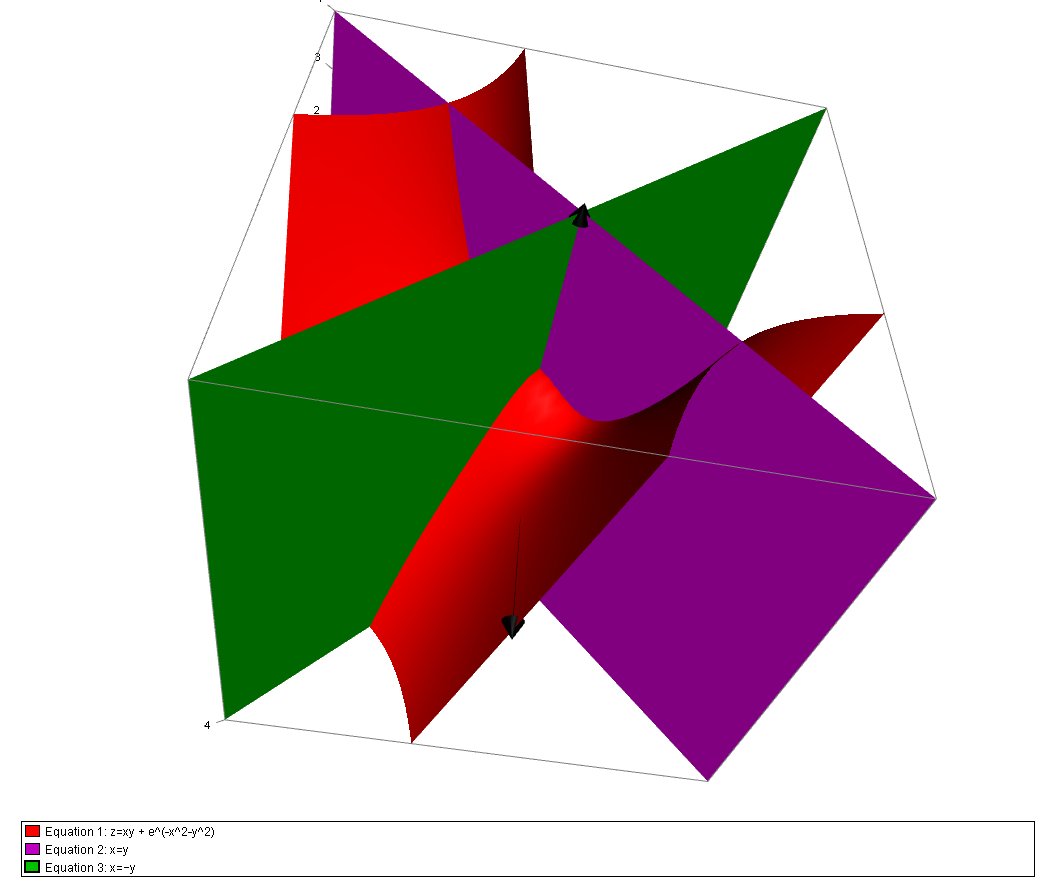What are the extrema and saddle points of #f(x, y) = xy+e^(-x^2-y^2)#?
1 Answer
We have:
# f(x,y) = xy + e^(-x^2-y^2) #
Step 1 - Find the Partial Derivatives
We compute the partial derivative of a function of two or more variables by differentiating wrt one variable, whilst the other variables are treated as constant. Thus:
The First Derivatives are:
# f_x = y + e^(-x^2-y^2) ( -2x) #
# \ \ \ = y -2x e^(-x^2-y^2)#
# f_y = x + e^(-x^2-y^2) ( -2y) #
# \ \ \ = x -2y e^(-x^2-y^2)#
The Second Derivatives (quoted) are:
# f_(x x) = -2e^(-x^2-y^2) +4x^2e^(-x^2-y^2) #
# f_(yy) = -2e^(-x^2-y^2) +4y^2e^(-x^2-y^2) #
The Second Partial Cross-Derivatives are:
# f_(xy) = 1+4xye^(-x^2-y^2) #
# f_(yx) = 1+4xye^(-x^2-y^2) #
Note that the second partial cross derivatives are identical due to the continuity of
Step 2 - Identify Critical Points
A critical point occurs at a simultaneous solution of
# f_x = f_y = 0 iff (partial f) / (partial x) = (partial f) / (partial y) = 0#
i.e, when:
# {: (f_x = y -2x e^(-x^2-y^2), = 0, ... [A]), (f_y = x -2y e^(-x^2-y^2), = 0, ... [B]) :}}# simultaneously
From which we can establish:
# [A] => y -2x e^(-x^2-y^2) = 0 => e^(-x^2-y^2) = y/(2x)#
# [B] => x -2y e^(-x^2-y^2) = 0 => e^(-x^2-y^2) = x/(2y)#
Thus we require that:
# y/(2x) = x/(2y)#
# :. x^2=y^2 #
Then we have two (infinite plane) solutions:
# :. x=+-y #
And so we conclude there are infinitely many critical points along the entire lengths of the intersection of the curve and the two planes
Step 3 - Classify the critical points
In order to classify the critical points we perform a test similar to that of one variable calculus using the second partial derivatives and the Hessian Matrix.
# Delta = H f(x,y) = | ( f_(x x) \ \ f_(xy) ) , (f_(yx) \ \ f_(yy)) | = | ((partial^2 f) / (partial x^2),(partial^2 f) / (partial x partial y)), ((partial^2 f) / (partial y partial x), (partial^2 f) / (partial y^2)) |#
# \ \ \ = f_(x x)f_(yy)-(f_(xy))^2 #
Then depending upon the value of
# {: (Delta>0, "There is maximum if " f_(x x)<0),(, "and a minimum if " f_(x x)>0), (Delta<0, "there is a saddle point"), (Delta=0, "Further analysis is necessary") :} #
# Delta = {-2e^(-x^2-y^2) +4x^2e^(-x^2-y^2)}{-2e^(-x^2-y^2) +4y^2e^(-x^2-y^2)} - {1+4xye^(-x^2-y^2) }^2 #
# \ \ \ = e^(-2 (x^2 + y^2)) (-8 x y e^(x^2 + y^2) - e^(2 (x^2 + y^2)) - 8 x^2 - 8 y^2 + 4) #
We need to consider the sign of
# Delta' = -8 x y e^(x^2 + y^2) - e^(2 (x^2 + y^2)) - 8 x^2 - 8 y^2 + 4 #
So, depending upon the sign

Here is a plot of the function

And here is a plot of the function including the planes


